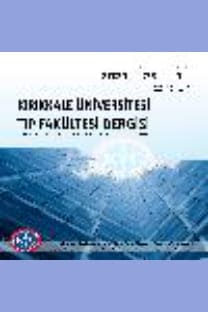KIRIKKALE ÜNİVERSİTESİ TIP FAKÜLTESİ HASTANESİ'NDE GÖZÜN ALINMASI ENDİKASYONLARI: SEKİZ YILLIK SONUÇLARIMIZ
Indications for Eye Removal Surgeries in Kırıkkale University Medical Faculty Hospital: Eight Year Experience
___
- Coden DJ. Orbital exenteration. In: Stephenson CM (ed) Ophthalmic Plastic, Reconstructive, and Orbital Surgery, 1st ed., Butterworth-Heinemann, Boston1997: 487-96.
- Perman KI, Baylis HI. Evisceration, enucleation, and exenteration. Otolaryngol Clin North Am. 1988; 21: 171-82.
- Walter WL. Update on enucleation and evisceration surgery. Ophthalmic Plast Reconstr Surg. 1985; 1: 243-52.
- Kaimbo K Causes of enucleation in Zaire. J Fr Ophtalmol. 1988; 11(10): 677-80.
- Shapiro A, Monselise MB. Destructive ophthalmic procedures, a comparison between a developed and a developing country. Albrecht Von Graefes Arch Klin Exp Ophthalmol. 1978; 207(4): 271-2.
- Andre OE, Viola AD, Godefroy K, Abduraman O, Assumpta LB, Come EM. Indications for destructive eye surgeries at Yaoundegynae-obstetric and paediatric hospital. Clin Ophthalmol. 2011; 5: 561-5.
- Su GW, Yen MT. Current trends in managing the anophthalmic socket after primary enucleation and evisceration. Ophthal Plast Reconstr Surg 2004; 20: 274-80.
- Hansen AB, Petersen C, Heegaard S, et al. Review of 1028 bulbar eviscerations and enucleations. Changes in aetiology and frequency over a 20-year period. Acta Ophthalmol Scand. 1999; 77: 331-5.
- Viswanathan P, Sagoo MS, Olver JM. National survey of enucleation, evisceration and orbital implant trends. Br J Ophthalmol. 2007; 91: 616-9.
- Genevois O, Millet P, Retout A, et al. Comparison after 10 years of two 100-patient cohorts operated on for eviscerations or enucleations. Eur J Ophthalmol. 2004; 14: 363-8.
- Kilmartin DJ, Dick AD, Forrester JV. Prospective surveillance of sympathetic ophthalmia in the UK and Republic of Ireland. Br J Ophthalmol. 2000; 84: 259-63.
- Yousuf SJ, Jones LS, Kidwell ED Jr. Enucleation and Evisceration: 20 Years of Experience. Orbit. 2012; 31(4): 211-5.
- Bekibele CO, Oluwasola AO. A clinicopathological study of orbito-ocular diseases in Ibadan between 1991-1999. Afr J Med Med Sci. 2003; 32(2): 197- 202.
- Haile M, Alemayehu W. Causes of removal of theeye in Ethiopia. East Afr Med J. 1995; 72 (11): 735-8.
- United State Eye Injury Register on line. Eye trauma epidemiology and prevention. Access date: 11 March 2015: http://www.useironline.org/ Prevention.htm.
- Dada T, Ray M, Tandon R, Vajpayee RB. A study of the indications and changing trends of evisceration in North India. Clin Exp Ophthalmol. 2002; 30(2): 120-3.
- Ibanga A, Asana U, Nkanga D, Duke R, Etim B, Oworu O. Indications for eye removal in southern Nigeria. Int Ophthalmol. 2013; 33(4): 355-60. doi: 10.1007/s10792-012-9700-8. (Epub 2012 Dec 29).
- Gyasi ME, Amoaku WMK, Adjuik MA. Epidemiology of hospitalized ocular injuries in the Upper East region of Ghana. Ghana Med J. 2007;41(4):171-5.
- Leonard MP, Andrew L, Beatrice B, et al. Characteristics and causes of penetrating eye injuries reported to the national eye trauma system registry, 1985-91. Public Health Rep. 1993; 108(5): 625-32.
- Andrew LD, Leonard MP, Ross JB, et al. Penetrating eye injuries in the work place. Arch Ophthalmol. 1992; 110(6): 843-8.
- Ababneh OH, AboTaleb EA, Abu Ameerh MA, Yousef YA. Enucleation and evisceration at a tertiary care hospital in a developing country. BMC Ophthalmol. 2015; 15: 120. doi: 10.1186/s12886- 015-0108-x.
- Köylü MT, Gökçe G, Uysal Y, Ceylan OM, Akıncıoğlu D, Günal A. Indications for eye removal surgeries. A 15 year experience at a tertiary military hospital. Saudi Med J. 2015; 36 (10): 1205-9. doi: 10.15537/smj.2015.10.12031.
- ISSN: 2148-9645
- Yayın Aralığı: Yılda 3 Sayı
- Başlangıç: 1999
- Yayıncı: KIRIKKALE ÜNİVERSİTESİ KÜTÜPHANE VE DOKÜMANTASYON BAŞKANLIĞI
İDRARDA PİYÜRİ VE KÜLTÜR SONUÇLARININ KARŞILAŞTIRILMASI
Birgül KAÇMAZ, SERDAR GÜL, Dilek KILIÇ, SEDAT KAYGUSUZ, Ergin AYAŞLIOĞLU, Okan ÇALIŞKAN, Ayşegül ASLAN, Gökçe TÜRKER
MEHMET ERHAN YUMUŞAK, ZAFER ONARAN, TEVFİK OĞUREL, NESRİN BÜYÜKTORTOP GÖKÇINAR, Yaşar ÖLMEZ
CHRYSEOBACTERIUM INDOLOGENES’İN NEDEN OLDUĞU İDRAR YOLU ENFEKSİYONU
Yasemin BAYRAM, Cennet RAĞBETLİ, Mehmet PARLAK, Nesrin CEYLAN, Hüseyin GÜDÜCÜOĞLU, Suat ÖZLÜK, Görkem YAMAN
Erhan YUMUŞAK, Zafer ONARAN, Tevfik OĞUREL, Nesrin BÜYÜKTORTOP, Yaşar ÖLMEZ
CHRYSEOBACTERIUM INDOLOGENES'İN NEDEN OLDUĞU İDRAR YOLU ENFEKSİYONU
Yasemin BAYRAM, Cennet RAGBETLİ, Mehmet PARLAK, Nesrin CEYLAN, Hüseyin GÜDÜCÜOĞLU, Suat ÖZLÜK, Görkem YAMAN
İNMENİN ÖNLENMESİNDE YENİ ORAL ANTİKOAGÜLAN AJANLAR
Humerus Cisim Kırıklarının Kilitli Kompresyon Plakları ile Tedavi Etkinliğinin Değerlendirmesi
Erkan AKGÜN, Ahmet Onur AKPOLAT, İsmail Burak ATALAY, Uğur TİFTİKÇİ, Mehmet EREN, Tuğrul YILDIRIM
İNTERNAL KAROTİS ARTER DİSEKSİYONU GELİŞEN BİR OLGUDA FİBROMUSKÜLER DİSPLAZİ: BİR OLGU SUNUMU
MEHMET FATİH ERBAY, SUAT KAMIŞLI
İDİOPATİK HİPOPARATİROİDZM TANILI HASTADA YAYGIN SİMETRİK İNTRAKRANİAL KALSİFİKASYONLAR: OLGU SUNUMU
MEVSİM FARKLILIKLARININ KATARAKT CERRAHİSİNİN SONUÇLARINA ETKİLERİ
